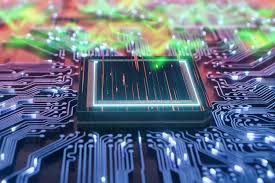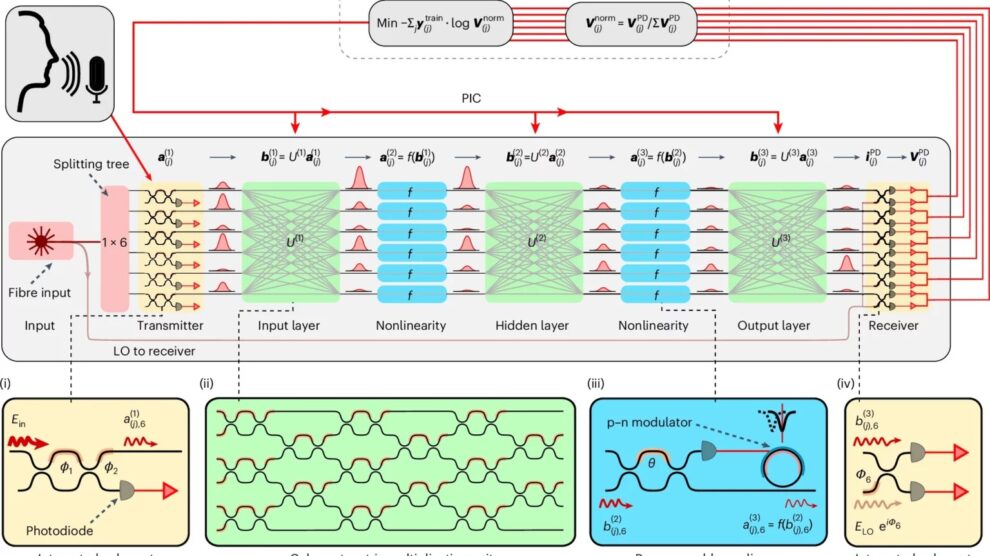MIT Researchers Unveil Photonic Processor for Faster, Energy-Efficient AI. This advancement has the potential to reshape how you experience AI technologies, from everyday applications on your devices to more complex, data-heavy operations in industries like healthcare, finance, and robotics. The core of this innovation is the use of light, rather than electrical signals, to process information, offering a glimpse into the future of computing.

As artificial intelligence becomes more deeply embedded in our daily lives, the demand for faster processing speeds and energy-efficient systems continues to grow. Traditional semiconductor-based processors, which rely on electrical signals to transfer data, have struggled to meet these needs as AI workloads increase in complexity. This is where MIT’s new photonic processor steps in. By using light instead of electricity, the researchers have developed a processor that not only accelerates the processing of information but also dramatically reduces the energy required for these operations.
Understanding Photonic Processors and Their Role in AI
At its core, the photonic processor leverages the properties of light to carry out tasks that were traditionally handled by electrical circuits. This shift to photonics is revolutionary because light can travel faster and more efficiently than electrical signals, making it an ideal candidate for speeding up AI computations. In a typical AI task, such as training machine learning models, large volumes of data must be processed rapidly, requiring substantial computational power. Traditional systems struggle with this demand, often consuming excessive amounts of energy to deliver the required processing speed. Photonic processors, however, can handle these tasks more efficiently, consuming significantly less power and reducing the environmental impact of running large-scale AI systems.
The potential applications of this technology are vast. From enhancing cloud computing services to improving autonomous vehicles, photonic processors could change the way AI applications are deployed across various sectors. The key to the processor’s success lies in its ability to use light for both data transfer and processing, effectively overcoming the limitations of traditional electronic circuits, which face challenges in scalability and heat generation as the demand for computing power increases.
How the Photonic Processor Works
The innovation behind MIT’s photonic processor involves the integration of photonics with traditional semiconductor technology. Unlike conventional processors that use electrical transistors to control data flow, the photonic processor uses tiny light signals to perform similar tasks. By manipulating light at incredibly small scales, these processors can perform multiple computations in parallel, drastically increasing their throughput. This parallelism allows for faster processing times, making the system ideal for handling the large, complex datasets that are characteristic of AI applications.
Another important aspect of the photonic processor is its use of optical switches. These switches control the flow of light within the processor, enabling the routing of light signals to different parts of the system. This system of light-based data transfer is not only faster but also generates less heat than electrical circuits, which are known to heat up quickly as they carry out high-speed computations. The reduced need for cooling solutions further contributes to the energy efficiency of the processor.
One of the most significant advantages of the photonic processor is its ability to perform computations at the speed of light. Because light travels at an incredibly fast rate, this processor can deliver results much quicker than traditional systems. For AI tasks that require rapid decision-making, such as real-time image recognition or speech processing, this speed can make a world of difference. As AI continues to evolve and become more integrated into various industries, the ability to perform such tasks in real-time will be crucial.
Advancements in Energy Efficiency
In the world of computing, energy efficiency is as important as processing power, especially as AI technologies become more widespread. The energy consumption associated with running AI algorithms, especially for tasks like training large-scale machine learning models, has been a growing concern. The MIT photonic processor, by using light instead of electricity, offers a solution to this problem. Light-based processors produce far less heat and consume significantly less energy, which can help reduce the environmental impact of running these AI systems.
For example, the processor’s ability to handle multiple computations simultaneously reduces the need for multiple processors to perform the same tasks. This parallel processing capability not only speeds up computations but also optimizes energy usage, reducing the overall power consumption of AI operations. This feature is particularly beneficial for large-scale AI systems that operate 24/7, as it allows them to run more efficiently without consuming excessive amounts of electricity.
By improving the energy efficiency of AI systems, the MIT photonic processor has the potential to make AI more accessible and affordable, particularly in industries where cost and energy consumption are major concerns. Furthermore, it could pave the way for more sustainable AI development, aligning with the growing emphasis on green technology and reducing the carbon footprint of digital infrastructures.
The Implications for AI Development and Real-World Applications
The impact of MIT’s photonic processor extends far beyond the research lab. With its combination of speed, energy efficiency, and scalability, this technology could drive major advancements in AI development. One area where it is particularly promising is machine learning, where large datasets must be processed quickly to train accurate models. The processor’s ability to handle these massive amounts of data in parallel could speed up the training process, enabling AI systems to become more intelligent in less time.
In fields like healthcare, where AI is increasingly being used to analyze medical images, predict patient outcomes, and assist in drug discovery, the ability to process information faster and more efficiently could lead to significant improvements in patient care. For example, AI systems that analyze medical scans could provide real-time results, helping doctors make faster, more informed decisions. Similarly, AI in the financial sector could be used to process and analyze vast amounts of financial data in real time, providing investors with actionable insights more quickly than ever before.
The processor’s applications are not limited to just AI development. It could also benefit industries such as telecommunications, autonomous vehicles, and robotics, where real-time data processing and low power consumption are crucial. By incorporating photonics into their systems, these industries could achieve faster, more efficient operations, unlocking new possibilities for innovation.
Challenges and Future Directions
While the potential of photonic processors is enormous, there are still challenges to overcome before they can be widely adopted. One of the biggest hurdles is the integration of photonics with existing electronic systems. Current computer architectures are built around electrical signals, so introducing a new form of data transfer could require significant changes to the way processors and chips are designed. Additionally, the technology is still in the experimental stages, and there may be unforeseen obstacles in scaling the photonic processors for mass production.
Moreover, while the processor’s energy efficiency is a major selling point, it remains to be seen how well the technology will perform in real-world applications at scale. Researchers will need to continue refining the design and testing the processors under various conditions to ensure they can meet the rigorous demands of large-scale AI systems.
Despite these challenges, the future of photonic processors looks bright. With the growing demand for more powerful and energy-efficient AI systems, innovations like the MIT photonic processor could play a key role in shaping the next generation of computing. As the technology matures, it could open the door to new applications and use cases, propelling AI into new industries and improving its capabilities across the board.
The unveiling of MIT’s photonic processor marks a significant milestone in the development of AI technology. By leveraging the power of light, this new processor promises to deliver faster, more energy-efficient AI processing, making it a game-changer for industries reliant on artificial intelligence. As the world increasingly relies on AI to drive innovation, the development of more efficient computing systems like the photonic processor will be key to unlocking new possibilities and ensuring sustainable growth in this field.
This advancement not only showcases the potential of photonics in computing but also underscores the ongoing push to make AI more efficient and accessible. With further research and development, MIT’s photonic processor could redefine the way AI operates, enabling faster, more powerful, and more sustainable AI systems that can meet the growing demands of the modern world.










Add Comment